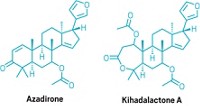Advertisement
Grab your lab coat. Let's get started
Welcome!
Welcome!
Create an account below to get 6 C&EN articles per month, receive newsletters and more - all free.
It seems this is your first time logging in online. Please enter the following information to continue.
As an ACS member you automatically get access to this site. All we need is few more details to create your reading experience.
Not you? Sign in with a different account.
Not you? Sign in with a different account.
ERROR 1
ERROR 1
ERROR 2
ERROR 2
ERROR 2
ERROR 2
ERROR 2
Password and Confirm password must match.
If you have an ACS member number, please enter it here so we can link this account to your membership. (optional)
ERROR 2
ACS values your privacy. By submitting your information, you are gaining access to C&EN and subscribing to our weekly newsletter. We use the information you provide to make your reading experience better, and we will never sell your data to third party members.
Natural Products
Study fills gaps in the momilactone biosynthetic pathway
Pathway that rice uses to inhibit competitors might be engineered into other plants
by Celia Henry Arnaud
October 28, 2020
| A version of this story appeared in
Volume 98, Issue 42
Rice plants release momilactones, a group of so-called allelopathic compounds that inhibit the growth of nearby competing plant species. If other plants could make these compounds, they could serve as biological herbicides.
Now, Elizabeth S. Sattely and Ricardo De La Peña of Stanford University have figured out the complete momilactone biosynthetic pathway, which could pave the way to engineering other plants to make the compounds (Nat. Chem. Biol. 2020, DOI: 10.1038/s41589-020-00669-3).
“Momilactones, I thought, were a really cool case because they had this known function. We thought if we could move the pathway, maybe we can move the function as well,” Sattely says. “We haven’t made stable lines or anything like that, but our work demonstrates that you can take the whole metabolic pathway, put it in another plant, and then isolate a compound that has the same [herbicidal] activities.”
To identify the missing pieces of the pathway, the researchers transiently expressed candidate genes in tobacco plants. To boost yields in tobacco plants, they needed to redirect some reactions from chloroplasts to the cytosol.
“You need to analyze whether your enzyme of interest has a chloroplast localization signal,” De La Peña explains. “If it does, then the only thing you have to do is truncate this peptide sequence, and the enzyme will no longer be able to relocate from the cytosol to the chloroplast.”
With this redirection, tobacco plants were able to synthesize 10 times as much momilactone as rice plants. Momilactone B extracted from tobacco plants inhibited the growth of Arabidopsis thaliana, verifying that the compound works even when made by a plant other than rice.
“Elucidation of this pathway has been a target for some time due to the import of the momilactones as the only really bona fide plant allelochemical. Identification of the relevant tailoring enzymes allows more precise dissection of this natural product, which may provide structure-function relationships for such allelochemical activity,” Reuben J. Peters, a biologist at Iowa State University who previously elucidated part of the momilactone pathway, says in an email. “Perhaps more importantly, it is now possible to consider importing the entire pathway into other plants to impart allelopathic properties that could serve as a natural weed suppression mechanism.”





Join the conversation
Contact the reporter
Submit a Letter to the Editor for publication
Engage with us on Twitter